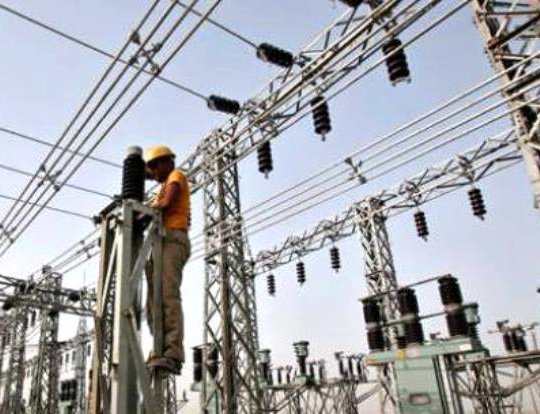
“Our goal here is to fundamentally change the way the world uses energy. The goal is a complete transformation of the entire energy infrastructure of the world.”
- Elon Musk, CEO of Tesla & Chairman of Solar City, May 2015
In many countries, the future of energy is now at the very top of the agenda. Demand for electrical power is growing three times as fast as the world’s population. By 2030, global electricity requirements could increase by two-thirds as illustrated in the figure below. At the same time, the challenges facing energy markets could scarcely vary more. While energy demand is increasing, cost-efficiency and, in some cases, climate protection is at the top of the agenda in most industrial countries. In all economies, however, sustainability and efficiency are essential [1] as illustrated in below energy matrix.
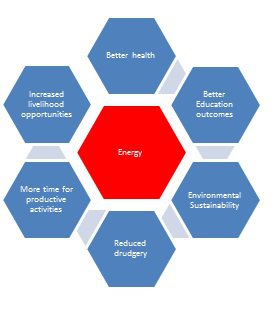
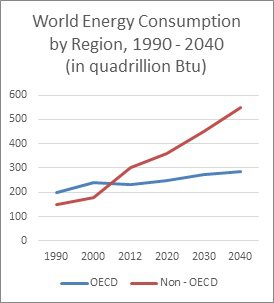 Source [2] BP, Renewable Energy – 2015 in Review
Source [2] BP, Renewable Energy – 2015 in Review
Two of our neighboring countries India and China now account for about half of global energy demand and its appetite continues to grow. How much energy will need when they reach the US and European level? According to the IEA, this figure will double by 2030.
The figure illustrates that the World Energy Consumption 1990 – 2040 by OECD and Non – OECD Countries, where we can see very clearly booming towards Non – OECD Countries. This is the key reasons that our neighboring countries are keen to invest in our energy resources for their growing demand, not for our help. Nepal should have to aware to protect our valuable energy resources for our future energy security.
The necessity of Energy mix:
“To make an energy fix, we need an energy mix.” - BP Slogan
Each energy sources has its own advantages and disadvantages, however, we have to try them together to ensure sustainable future for energy customers around the world. The traditional source of energy like Oil, Coal, and Gas could run out in the next century. Unless alternative sources are found and start to adopt the energy mix. The world needs to find a way to produce more electricity in a cleaner, greener way if we don’t want to suffer an energy crisis in the very near future.
Nepal’s electricity demands are currently met by energy generated 99% from hydropower, which is not an energy mix. By finding the right mix of energy sources, Nepal can balance out the strengths and weaknesses of each individual source. We believe that the largest part of the mix must be hydropower since Nepal has estimated 45,000 MW of technically feasible hydropower including over 100 MW of micro hydropower. 2100 MW of solar power, 3000 MW of wind power and similarly, it is estimated that 1.1 million domestic biogas plants can be developed in the country [3]. So, we must harness energy from various sources equally for future reliability. Ironically, despite having that much energy mix Nepal is suffering long load shedding every day and importing 450 MW from Neighboring countries to make balance in the system and paying 20 billion Nepali rupees to India every year only in Electricity and 1.3 million tonnes of refined fuels every year which cost 109 billion and billions of rupees for LPG gas.
To meet the growing electricity demand (1495MW Peak demand as of recent Laxmi puja’s day), imports from India have increased over the last 15 years. In 2015 – 16, Electricity imports from India accounted for 34% (450 MW in 2017) of total energy supply in Nepal. Therefore, investments in hydropower can help the country address its crippling power shortage problem and can be best addressed by the private sector in the immediate and medium-term future given the financial limitations of Nepal Electricity Authority and the Government of Nepal[4]. However, I would like to argue that, besides the history of more than century-long Hydropower generation in Nepal, we hardly generate less than 1000 MW yet. Development of Hydropower Projects is really sluggish [5]. Most of the projects have been delayed on their promised schedule. Political corruption and financial inabilities are the main reason behind it as Nepal listed rank 131in the data of Transparent International’s Corruption Perceptions Index [6]. Most of the government funded projects show Time and Cost overrun situation [7]. As most of the donor-funded projects tend not only to incur time overruns but also cost overruns.
In addition, Inadequate planning and investment in generation, transmission, and distribution, delays in project implementation due to the lack of adequate legal and regulatory frameworks to resolve land acquisition, and rights of way and forest clearance processes have hampered the development of hydro resources, resulting in the severe underdevelopment of energy infrastructure[8].
Furthermore, most of the hydropower projects are Run of River type which depends on the monsoon and flow of river so in dry season, they only produce below half of their capacity. Kulekhani I and II, totaling 92 MW, is the only storage project in Nepal. Nepal should have developed more storage type Hydro Power, however, which is obviously very costly and time-consuming.
The main reason behind this time and cost overruns are mostly due to NEA’s centralized and prolonged procurement processes, to ghost contractors leaving work to be executed by inexperienced and technically and financially weak local contractors, low project readiness at project approval, weak project management capacity of NEA [8].
Moreover, deferred investment in electricity infrastructure has caused severe power cuts compelling industrial and commercial entities to operate costly generators. The import of petroleum products exceeds total exports and thereby is a major reason for the country’s large trade deficit. In the absence of cost-based tariff adjustment for the last three years, the financial health of the NEA has deteriorated making it unable to invest in infrastructure to meet the rising demand for electricity. The total losses of NEA at present have reached NPR 27 billion despite the government written off NPR 27 billion in 2011[9].
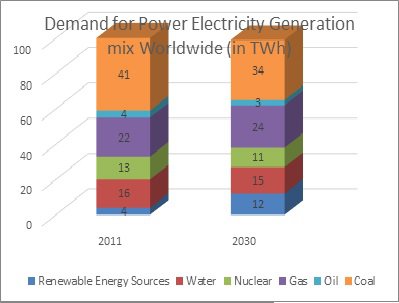 In this situation, Nepal should have to think seriously about their energy mix. As Nepal has plenty of other renewable energy resources as shown in the table above. Nepal should have to invest in PV solar, Wind turbine, small hydro and Biomass simultaneously with the big hydro project for the long-resolution as PV and Biomass can help to maintain present energy crisis very quickly. As renewable energy sources in power generation continued to increase in 2015, reaching 2.8% of global energy consumption, up from 0.8% a decade ago. At the individual country level, RE sources are already playing a vital role in some countries. Denmark leads, with 66% of power coming from renewable, followed by Portugal with 30%. Among the larger EU economies, the renewable share is 27% in Germany, 24% in Spain, and 23% in both Italy and the UK [1].
In this situation, Nepal should have to think seriously about their energy mix. As Nepal has plenty of other renewable energy resources as shown in the table above. Nepal should have to invest in PV solar, Wind turbine, small hydro and Biomass simultaneously with the big hydro project for the long-resolution as PV and Biomass can help to maintain present energy crisis very quickly. As renewable energy sources in power generation continued to increase in 2015, reaching 2.8% of global energy consumption, up from 0.8% a decade ago. At the individual country level, RE sources are already playing a vital role in some countries. Denmark leads, with 66% of power coming from renewable, followed by Portugal with 30%. Among the larger EU economies, the renewable share is 27% in Germany, 24% in Spain, and 23% in both Italy and the UK [1].
Renewable Energy implementation and projects are needed to be promoted by the government of Nepal. These projects require Renewable Energy Technology procedure to sell their energy. The GoN must be lenient to introduce an investment-friendly RET as Nepal has a great potential in Solar PV, Wind Energy, Small Hydro, and Biomass. Energy Efficiency measure should be implemented very seriously. Nepal should invest huge amount on modern infrastructure to save T&D losses. In successful measuring energy efficiency performance to raise industrial efficiency, the government can play several important roles and should be especially aware of its influence on policy development and data collection. Proper use of measuring energy efficiency performance, international sharing of policy information and practical cooperation with industries are critical to the society-wide conservation of energy.
Lesson from Germany:
Germany’s Renewable Energy Act (EEG), which governs the priority afforded to renewable energy sources, went into effect in April 2000. The law has played a key role in the country’s renewable energy boom and has since been copied by 50 countries worldwide, according to the Fraunhofer Institute for Wind Energy and Energy System Technology. The EEG requires grid operators to purchase electricity from renewable sources at a set price from those who produce it. Nepal has more solar irradiance than Germany so if we apply German model and let 100000 household of Kathmandu and 100000 government Buildings schools ‘colleges, and Hospitals put Grid connected rooftop PV there is no energy crisis in Nepal.
Nevertheless, Nepal’s energy problems are arguably rooted more in shortages of governance than of pure supply. The energy sector suffers from widespread inefficiencies, including transmission and distribution (T&D) losses that exceed 34 percent up to some years which is highest in the region according to the World Bank data. NEA has lost billions of rupees. The losses are caused by bad equipment, poor maintenance, and energy theft. However, there are very few studies have been done in the field of System loss and Electricity theft side in Nepal. Some expert believes that there is about 10 % electricity is lost by theft. As we know the famous transformer scandal Nepal’s Commission for the Investigation of Abuse of Authority (CIAA) arrested 22 senior Nepali officials of NEA and 2 Chinese suppliers on suspicion of corruption. The Chinese company promised to supply electric transformers with copper wiring; but under inspection, several transformers were found to have aluminum rather than copper wires, a scam worth US$ 1.7 million [10] As Transformer is the heart of electrical power system what would happened if NEA put faulty thousands of transformers around the Country ? that caused the NEA’s 530 transformers 90 in the Kathmandu valley alone, have been damaged beyond the repair which has caused financially losses of NPRs 150 million according to NEA’s official[11]. Furthermore, 12 NEA’s employees involved in tempering with electrical meters and defrauding the government owned power monopoly for last 12 years [12]. Free special feeder to high class industrial customers for various parts of Countries. In this situation, the New management of NEA is still trying their best to minimize the load shedding hours by demand side management, proper energy management and fixing the loop whole around projects that have delayed for years. How we could believe such kind of irregularities have been happening for years in one of the government owned company? This is the main reason of energy crisis in Nepal.
Table 1Power and Communication Scenario of some countries
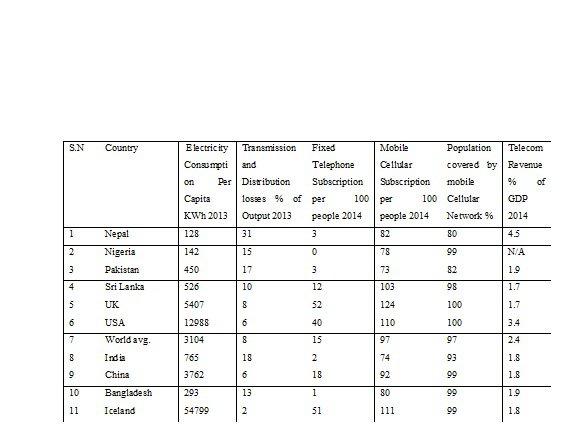
Source [13]
The global market for rooftop photovoltaic panels was nearly US$ 30 billion in 2016 and is expected to grow by 11 percent over the next six years, according to a study by Research and market. Recently, Nepal government has granted the permission to connect rooftop PV to national grid is very welcome news.
As Nepal has 300 days sunny weather per annum and thus is very rich in solar power potential. Using PV module of 12% efficiency, total energy generated will be as follows where assuming peak sun to be 4.5 hours.
This energy generated is more than energy required for fulfilling the whole energy demand of the world.
Furthermore, NEA, which ended the power cuts (load-shedding) since October 2016, has been emphasizing that initiatives for using and the purchase of electric vehicles to reducing large petroleum import should be taken at the state and the citizens’ level. Charging stations would be set up at various places in Kathmandu in the first phase and in Pokhara, Chitwan, Biratnagar, and Nepalgunj among other places after that. This is the right way where we could bring country towards energy independent. If we use all our energy in the future by replacing LPG gas as well, we could save huge sum of money for investment in Renewable energy sources.
Finally, Nepal is blessed with enormous renewable energy resources and a history of more than century long hydropower development. Nevertheless, inadequate and less progressive vision and policies, uncontrolled demand growth; and unhealthy political economies have caused in a large and expensive energy gap that may spiral out of economic control by the end of the decade. However, more sustainable vision and appropriate action plans, more focus on research and development (R&D) can be taken to incentivize new green investment and reduce huge system loss might control the rooted energy crisis very soon.
References:
[1] Siemens, “Sustainable Power Generation: The Future of Energy - Energy & Efficiency - Pictures of the Future - Innovation - Home - Siemens Global Website,” 2014. [Online]. Available: http://www.siemens.com/innovation/en/home/pictures-of-the-future/energy-and-efficiency/sustainable-power-generation-the-future-of-energy.html.
[2] BP, “Renewable energy - 2015 in review | Statistical Review of World Energy | Energy economics | BP Global,” 2015. [Online]. Available: http://www.bp.com/en/global/corporate/energy-economics/statistical-review-of-world-energy/renewable-energy.html.
[3] “Government of Nepal Water and Energy Commission Secretariat Energy Sector Synopsis Report,” 2010.
[4] USAID, “Nepal Hydropower Development Program (NHDP),” Fact sheet, 2015.
[5] Poudyal, Ramhari; Khadka, Shree Krishna; Loskot, Pavel “Understanding Energy Crisis in Nepal Assessment of the country’s Energy Demand and Supply in 2016,” IEEE Conf. 2017, March, 2017.
[6] Transparency International, “Transparency International Corruption Perceptions Index 2016,” 2016.
[7] R. Poudyal, “Could Micro grids are the efficient way to overcome Nepal’s energy crisis?” The Kathmandu Post 15-Oct-2017.
[8] Government of Nepal, Nepal Portfolio Performance Review (NPPR) 2015. 2015.
[9] R. Pageni, “My Republica - NEA’s annual loss doubles to Rs 11.57 billion,” 2016. [Online]. Available: http://www.myrepublica.com/news/3235.
[10] K. Parajuli, “NEPAL - CHINA China tries to cover up giant corruption scandal in Nepal,” AsiaNews.it, 2013.
[11] S. Bashyal, “Transformer blasts common in Valley - The Kathmandu Post,” 12-Dec-2015.
[12] The Himalayan Times, “12 Nepal Electricity Authority staff among 16 held for electricity theft,” The Himalayan Times, 2017. [Online]. Available: https://thehimalayantimes.com/kathmandu/police-bust-16-members-electricity-theft-racket/. [Accessed: 23-Oct-2017].
[13] World Bank, “The World Bank Databank,” Data Bank, 2016. [Online]. Available: http://databank.worldbank.org/data/home.aspx.
















